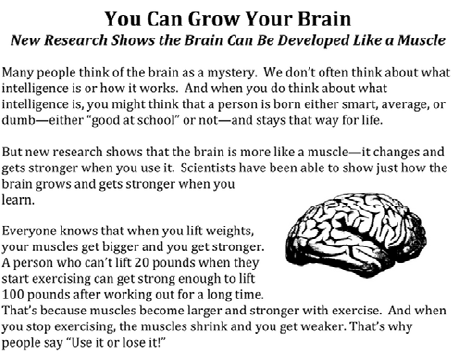A Growth Mindset and a Sense of Belonging Prevents School Dropouts
The title of this article is a bit misleading. Attending college in an elite institution in the Philippines was not normal for my socio-economic status. Seeing a "G" on a paper I turned in and later hearing the professor explained that "G" did not mean "good", but "very bad grammar", could have easily made me feel ostracized and not good enough for college. Hearing a professor say that I had nothing between my ears did not help either. But I probably knew then that there were others before me who had experienced major setbacks but did not give up. I perhaps believed then that becoming a chemist was not something I was born with, but was something I needed to work hard for. Honestly, what worked for me was support and confidence from my peers and mentors.
Results recently published in the Proceedings of the National Academy of Sciences show that simple interventions can improve the survival rate of colored and disadvantaged students in college. The intervention could be as simple as asking a student to read a four-page article (an excerpt has been provided by the authors):
Wall Street Journal as "The researchers didn’t tell people to have a better attitude. They just encouraged students and teachers to articulate their own best impulses. That changed mind-sets—and changed lives." The results are indeed very encouraging. The following graphs copied from the paper show the significant effects:
Results recently published in the Proceedings of the National Academy of Sciences show that simple interventions can improve the survival rate of colored and disadvantaged students in college. The intervention could be as simple as asking a student to read a four-page article (an excerpt has been provided by the authors):
Wall Street Journal as "The researchers didn’t tell people to have a better attitude. They just encouraged students and teachers to articulate their own best impulses. That changed mind-sets—and changed lives." The results are indeed very encouraging. The following graphs copied from the paper show the significant effects:
The article of Gopnik unfortunately is misleading, the same way the title of this blog post is misinforming. Fortunately, the press release from the University of Texas regarding this study does not fail to cite the following very important point:
"The authors emphasized that these exercises do not work in isolation but help students take advantage of opportunities available to them, such as academic assistance or student organizations. For the exercises to be effective, students need access to such resources and support."And the following graphs demonstrate the resources and support that are in fact responsible for the resilience observed in disadvantaged students.
- Living on campus
- Social and academic integration
- Making close friends in college
- Academic support services
- Extracurricular involvement
- Developing a mentor relationship
The above obviously applies as well to basic education. And I can say this again, "Honestly, what worked for me was support and confidence from my peers and mentors."



Comments
Post a Comment